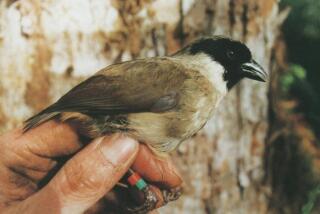Collectors Covet Endangered Species for Profit, Prestige
- Share via
Some wildlife collectors covet endangered species, illegally snatching them from the wild to savor at home or to trade or sell.
“Generally more money is had, ounce for ounce, on endangered plants and animals than on cocaine,” maintains Assistant U.S. Atty. Lee Altschuler, who has prosecuted collectors for violating the U.S. Endangered Species Act. “Parrots can go for 10 grand or more.”
Federal wildlife officials avoid publishing the locations of endangered cacti because collectors dig them up. Endangered reptiles also are prime merchandise. Reptile collectors like them both dead--stuffed and mounted--and alive.
Altschuler said he has discovered reptile collectors who like to lie down with endangered snakes, get drunk and then fall asleep with them. “It’s very weird,” he said.
Collectors, however, defend their hobby. They say they have contributed much to the knowledge of many kinds of wildlife, especially butterflies.
“Probably collecting is going to have some detrimental impact on the (butterfly) populations,” said Rosser Garrison, an entomologist who studies dragonflies, “but it is going to be exceedingly minor compared to habitat destruction.”
Some butterfly collectors have snatched endangered butterflies from the wild or stolen their caterpillars, raised them at home and killed them after they emerged from their cocoons to add them to their collections.
Starting with the caterpillar yields a better specimen, one expert explained, because flying around batters the wings.
“If something is listed as endangered, it is more valuable because it is harder to get,” said Scott Pearson, a senior resident agent for the U.S. Fish and Wildlife Service. “There’s a certain, ‘Gosh, I’ve got this endangered species in my collection.’ It gives you more bragging rights.”
More to Read
Sign up for Essential California
The most important California stories and recommendations in your inbox every morning.
You may occasionally receive promotional content from the Los Angeles Times.














